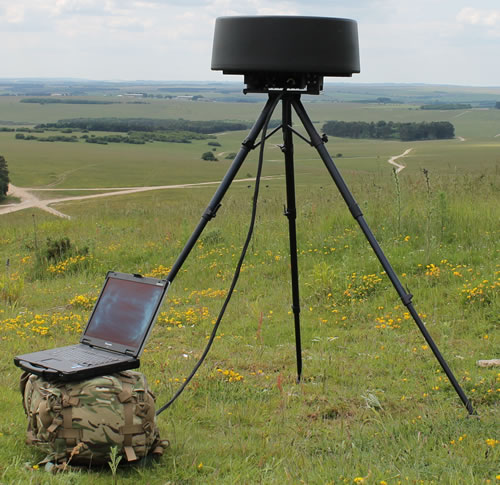Perimeter (Surveillance) Radar

Figure 1: Kelvin Hughes SharpEye™ SxV X-Band Doppler radar.
Perimeter (Surveillance) Radar
Perimeter radars (or Perimeter surveillance radars) is a class of radar sensors that monitor hostile activity on the surroundings of critical infrastructures or objects worthy of protection. Such radars typically have ranges of several hundred meters to over a couple of 10 kilometers. They operate at very high frequencies, mostly in X–, Ku-Band or use millimeter waves with narrower beams to provide high accuracy and resolution.[1]
Perimeter radars are often part of a security network. The radar autonomously detects movement in a defined area, tracks those targets and raises an alarm if the targets cross into alarm areas. It doesn't require operating personnel mostly. For target identification, it is often coupled with an electro-optic camera sensor with a slew to cue functionality. Such radar is characterized by its ability to detect movement at the ground level of targets such as an individual walking or crawling towards a facility. The radar must be able to detect, for example, a single swimmer or diver at the water surface despite a heavy swell. It must discard nuisance targets caused by, for example, an animal.
Perimeter radars for mobile use are lightweight and quickly and easily deployed on a tripod or as a single mast version on a vehicle for battlefield situational awareness.
Applications
Perimeter security represents one of the most important yet difficult security challenges facing the global economy today. High material and ideal values are often a tempting goal for those who try to inflict maximum economic and physiological damage on society. Airports, seaports, rail stations, large petrochemical plants, government buildings, and nuclear power plants are all at risk. Perimeter radars can be used for:
- border security;
- base protection;
- perimeter and CNI protection;
- airport, port or harbor security;
- UAV and “drone” detection radar;
- military battlefield surveillance radar;
- wildlife and game reserve observation.
Sources and ressorces:
- Michael Caris, „Kleindrohnendetektion mit Millimeterwellen-Radar“, Fraunhofer-Institut für Hochfrequenzphysik (online)
